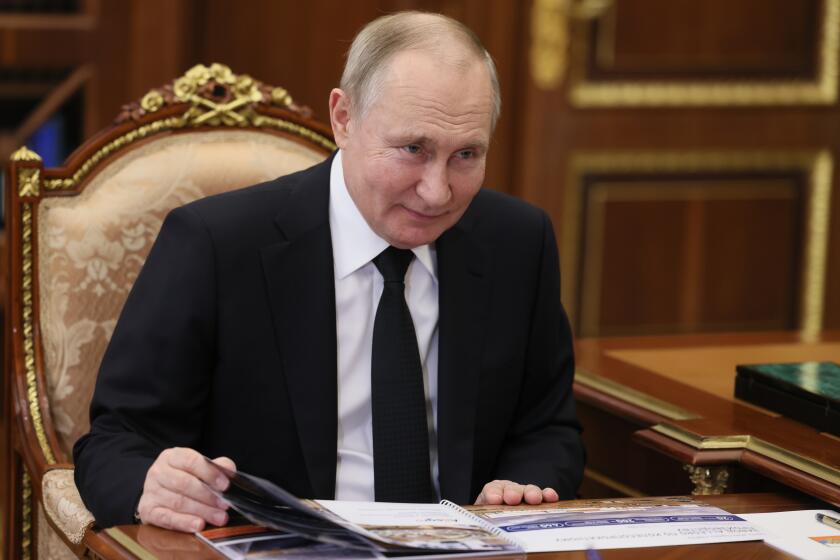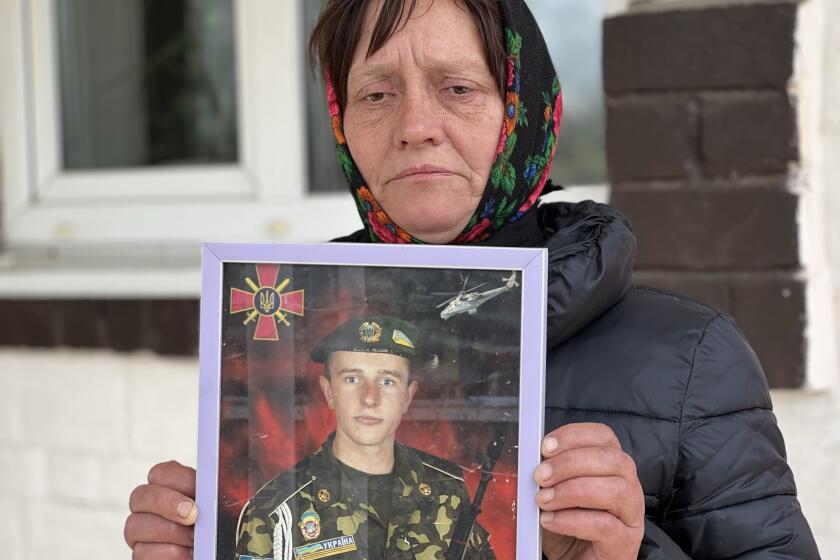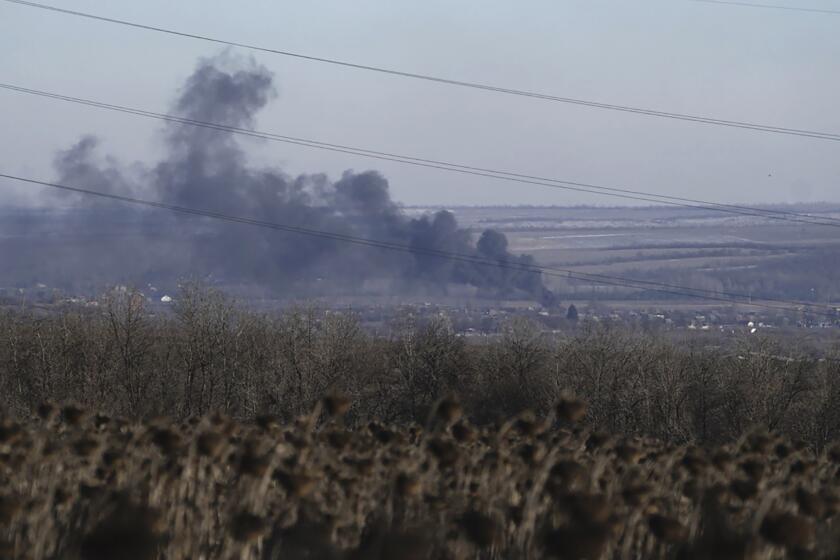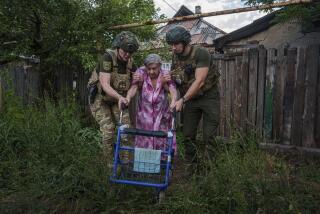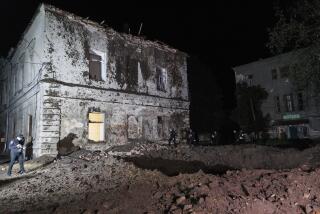Toll in Russian strike on Ukrainian apartment building reaches 45, including 6 children
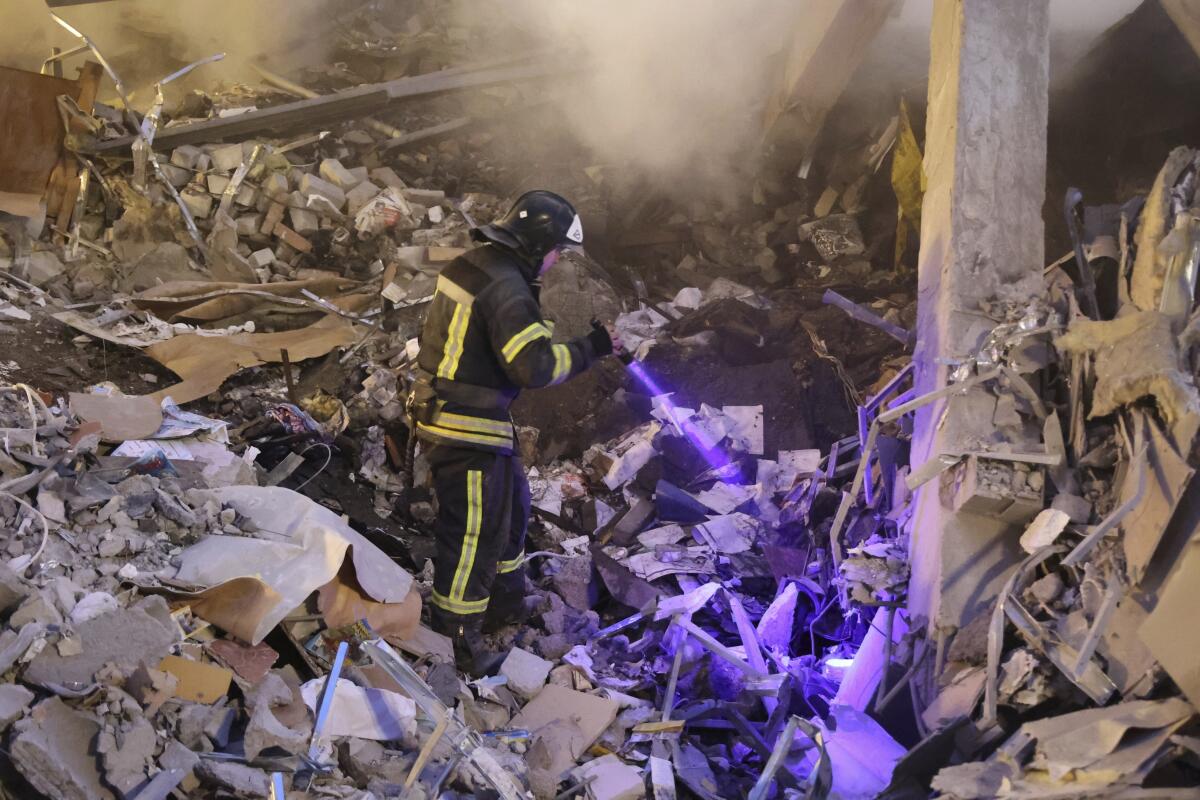
- Share via
DNIPRO, Ukraine — The death toll from the Ukraine war’s deadliest attack on civilians at one location since last spring, a weekend Russian missile strike on a southeastern apartment building, has reached 45, officials said Tuesday.
Those killed in the Saturday afternoon strike in Dnipro included six children, and 79 people were injured, President Volodymyr Zelensky wrote on the Telegram messaging app. The toll included two dozen people initially listed as missing at the multistory building, which housed about 1,700, according to Kyrylo Tymoshenko, deputy head of the Ukrainian presidential office.
Emergency crews cleared away about 10 tons of rubble during a nonstop search-and-rescue operation, the Dnipro City Council said. Some 400 people lost their homes, with 72 apartments ruined and an additional 236 damaged beyond repair, it said.
People converged at the site Tuesday to lay flowers, light candles and bring plush toys. For a third day in a row, Dnipro resident Oleksandr Pohorielov came to mourn.
“It’s like coming to the cemetery to your family. It’s a memory, to say a proper goodbye. To remain a human after all,” he explained as an intense reek of burning emanated from the building’s ruins.
Volunteers helped Nadiia Yaroshenko’s son escape from their third-floor apartment on a makeshift ladder, but their white cat Beliash refused to leave. He remains in his favorite place at a window that is now blown out, Yaroshenko said, desperately trying to see him from the courtyard with a flashlight.
“We cannot reach the apartment even with rescuers because the apartment is in an emergency and dangerous condition. Walls could collapse there every minute,” she said.
U.K. prime minister promises to provide tanks and artillery systems to Ukraine amid renewed missile attacks by Moscow targeting Ukrainian cities.
The latest deadly Russian strike on a civilian target in the almost 11-month-old war triggered outrage. It also prompted the surprise resignation Tuesday of a Ukrainian presidential advisor who had said the Russian missile was shot down by Ukraine’s air-defense system and exploded when it fell — a version that would take some of the blame off the Kremlin’s forces.
Oleksii Arestovich’s comments in an interview Saturday night caused an outcry. He said as he quit that his remarks were “a fundamental mistake.” Ukraine’s air force had stressed that the country’s military did not possess a system capable of downing Russia’s Kh-22 missiles, which it said was the type that hit the apartment building.
Zelensky vowed to bring those responsible for the strike to justice.
President Vladimir Putin claims that Russia’s nuclear arsenal is ‘more advanced’ than that of any other nation.
“We will use all available opportunities — both national and international — to ensure that all Russian murderers, everyone who gives and executes orders on missile terror against our people, face legal sentences. And to ensure that they serve their punishment,” he said Monday in a video address.
The British Defense Ministry said Tuesday that the weekend barrage of long-range missiles, the first of its kind in two weeks, targeted Ukraine’s power grid.
Some wars end with victory parades. Others simply halt without anyone winning or losing. That may be where Ukraine is headed — a frozen conflict.
The Kh-22 was designed during Soviet times to strike enemy ships. It can also be used against ground targets, but with much less precision. Observers have said that Russia has increasingly used older weapons, including those intended for other purposes, to attack targets in Ukraine in what could be a sign of the depletion of Russian stockpiles of modern precision weapons. The U.K. ministry noted that the Kh-22 “is notoriously inaccurate when used against ground targets as its radar guidance system is poor at differentiating targets in urban areas,” suggesting that might have been a factor in the deaths in Dnipro.
Similar missiles were used in other incidents that caused high civilian casualties, it said, including a strike on a shopping mall in the central Ukraine city of Kremenchuk in June that killed 20 people.
The deadliest attack involving civilians before Saturday was an April 9 strike on a train station in the eastern city of Kramatorsk that left at least 52 people dead, according to the Associated Press-Frontline War Crimes Watch project.
As Russian troops wage a ferocious fight to advance in east Ukraine, a parallel battle is unfolding in the top echelons of military power in Moscow.
In Moscow, a makeshift memorial to the Dnipro attack’s victims appeared in front of an apartment building, an unusual act in Russia, where even a hint of criticism of the government’s “special military operation” in Ukraine is often suppressed. Amid snow, flowers and toy stuffed animals were laid at the monument of prominent Ukrainian writer Lesya Ukrainka, along with a photo of the destroyed building and a sign that
read in Russian: “Dnipro. 14.01.2023.”
Attacks on civilians have helped stiffen international support for Ukraine as it battles to fend off the Kremlin’s invasion. The winter has brought a slowdown in fighting, but military analysts say a new push by both sides is likely once the weather improves.
Underscoring Russia’s growing military needs, Defense Minister Sergei Shoigu said Tuesday that the country’s military would increase its readiness from the current 1.15 million to 1.5 million in coming years.
As part of the buildup, the military will form an army corps in the northwestern region of Karelia, near Finland, as well as three new motorized infantry and two airborne divisions. The military will also beef up seven existing motorized infantry brigades into divisions.
On the side of Ukraine, the top U.S. military officer, Army Gen. Mark A. Milley, traveled to the Ukraine-Poland border on Tuesday to meet with his Ukrainian counterpart for the first time. Milley, the chairman of the Joint Chiefs of Staff, met with Gen. Valerii Zaluzhnyi, at an undisclosed location. On Monday, Milley visited Ukrainian troops training at a military base in Germany under U.S. commanders.
Start your day right
Sign up for Essential California for the L.A. Times biggest news, features and recommendations in your inbox six days a week.
You may occasionally receive promotional content from the Los Angeles Times.
Ukraine’s first lady was doing her part Tuesday to help. She pressed world leaders and corporate executives at the World Economic Forum’s annual gathering in Davos, Switzerland, to exercise their influence against a Russian invasion she said is leaving children dying and the world struggling with food insecurity.
As the first anniversary of the war nears, Olena Zelenska said parents in Ukraine are in tears watching doctors trying to save their children, farmers are afraid to return to their fields filled with mines, and “we cannot allow a new Chernobyl to happen,” referring to the 1986 nuclear power plant disaster.
“What you all have in common is that you are genuinely influential,” Zelenska told attendees. “But there is something that separates you, namely that not all of you use this influence, or sometimes use it in a way that separates you even more.”
Meanwhile, the head of the United Nations nuclear agency is visiting several of Ukraine’s four nuclear power plants this week to oversee the establishment of a permanent presence of inspectors at each of them to oversee operations and ensure safety.
Rafael Mariano Grossi, director-general of the International Atomic Energy Agency, said Tuesday that the missions “will make a very real difference through supporting the Ukrainian operators and regulator in fulfilling their national responsibility of ensuring nuclear safety and security.”
More to Read
Sign up for Essential California
The most important California stories and recommendations in your inbox every morning.
You may occasionally receive promotional content from the Los Angeles Times.

